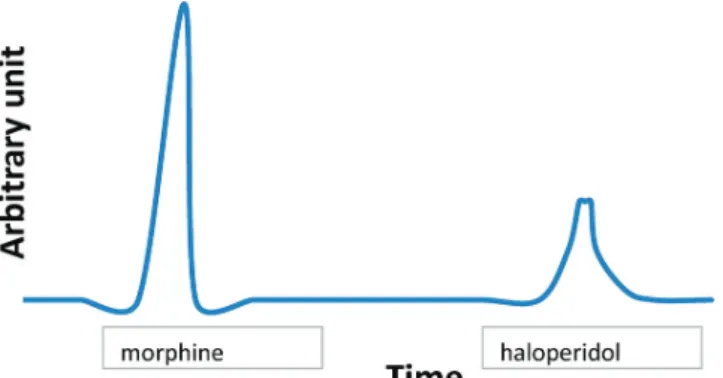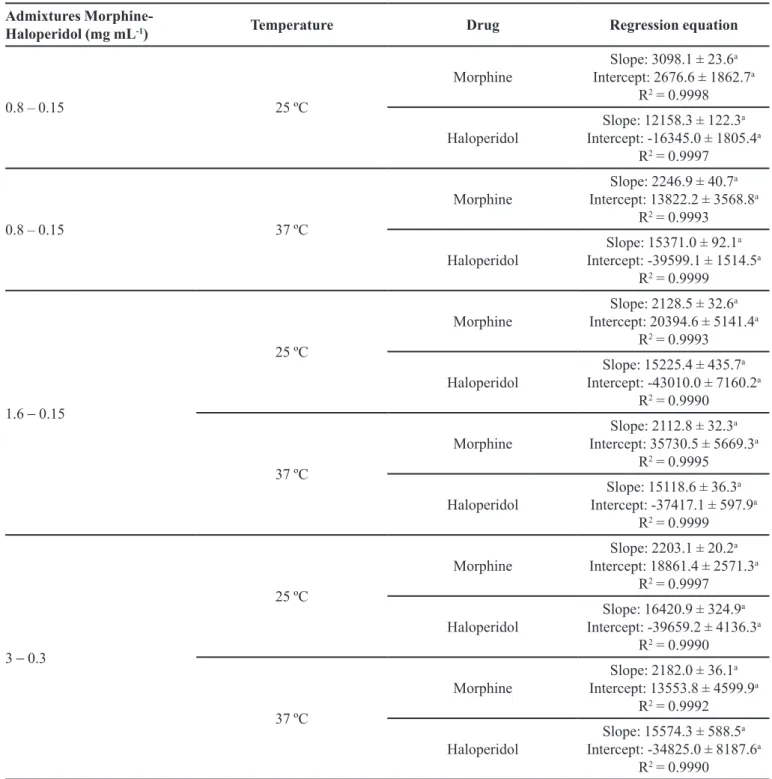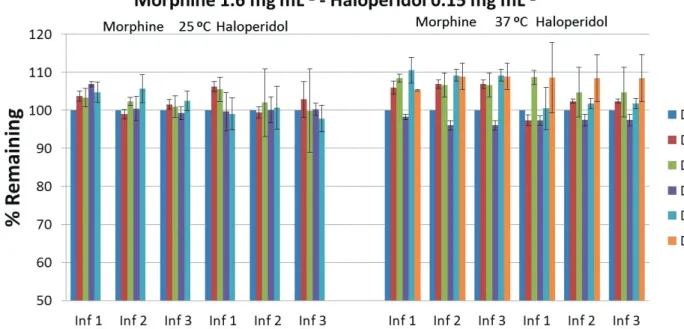http://dx.doi.org/10.1590/s2175-97902018000217352
Article
*Correspondence: Sánchez Rojas Fuensanta. U/niversity of Málaga, Depart-ment of Analytical Chemistry, Faculty of Sciences, Universidad de Málaga, Campus Teatinos s/n, 29071, Málaga, Spain. Phone: +34 952137393. E-mail: fsanchezr@uma.es
Determination of compatibility and stability of haloperidol and
morphine mixtures used in palliative care
Espinosa Bosch María
1, Sánchez Rojas Fuensanta
2, Bosch Ojeda Catalina
21UGC Pharmacy, Regional Universitary Hospital of Málaga, 2Department of Analytical Chemistry, Faculty of Sciences,
University of Málaga, Spain
With the aim of controlling various symptoms, possible to use mixtures of different drugs within infusion devices. This should take into account the compatibility of the mixture. Factors influence the compatibility
and stability of the mixtures are: drug type, concentration, solvent, temperature and light. When evaluating the compatibility of the mixtures for infusion for subcutaneous via is important to consider infusion devices used and the conditions of light and temperature should simulate as far as possible the conditions in practice assistance. There are diverse studies that analyze the compatibility of drug mixtures, but there
are still many possible combinations of drugs for which evidence is not available. The objective of this work is to study the compatibility and stability of several mixtures of haloperidol and morphine that can
be used in solution for subcutaneous infusion.
Keywords: Haloperidol/stability/compatibility. Morphine/stability/compatibility. Mixtures. Palliative care.
INTRODUCTION
Cancer patients who are in the terminal phase
simultaneously suffer from various symptoms such as pain, nausea, anxiety, gastrointestinal obstruction
and weakness, so that to control these symptoms, simultaneous administration of morphine with other
drugs, including haloperidol, is necessary (Schrijvers
et al., 1998).
On the other hand, many patients have great difficulty in taking oral medications. In these patients,
portable infusion pumps offer the possibility of continuous parenteral administration of drugs while maintaining patient autonomy. To avoid the use of different infusion needles it is very useful to mix different drugs in a single
infuser (Graham, Clark, 2005).
In the subcutaneous administration of drug mixtures, by means of infusors, incompatibility thereof or loss of stability may occur. Incompatibility may lead to precipitation or crystallization of the drugs leading
to cannula blockage, skin irritation and malabsorption (Grassby, Hutchings, 1997).
The physical compatibility and / or stability of mixtures of several drugs in solution for use in subcutaneous infusion has been extensively studied, although in some studies only a visual inspection of the
samples was performed, thus obtaining information on the
physical compatibility but not on the chemical stability of the drugs in the mixture (Barcia et al., 2003; Barcia et al.,
2005; Good, Schneider, Ravenscroft, 2004; Negro et al.,
2006; Negro et al., 2007).
Morphine is an opioid analgesic used for the treatment of moderate to severe pain. It is recommended by the WHO for the relief of moderate cancer-related pain. It is the opioid of choice in palliative and terminal care. Morphine is predominantly cleared from body by metabolism to morphine- 3-glucuronide (M3G) and morphine-6-glucuronide (M6G). Haloperidol is a neuroleptic, conventional antipsychotic drug that is part of the butyrophenones.
The objective of this work is to evaluate the
compatibility and stability of the mixtures of morphine
and haloperidol prepared with NaCl 0.9% at different
concentrations stored in elastomeric infusors at 25 ºC and
MATERIAL AND METHODS
Chemical and reagents
Commercial morphine ampoules of 20 mg mL-1 (Morphine, Braun, Spain) and commercial haloperidol ampoules of 5 mg mL-1 (Dr. Esteve Laboratory, Spain) were employed. Sodium chloride 0.9% was obtained from Fresenius Kabi, Spain. Other chemical and solvents were
of analytical grade and obtained from Sigma-Aldrich,
Germany. High purity water (resistivity 18.2 MΩ cm) obtained by a Milli-Q water purification system (Millipore, Bedford, MA, USA) was used throughout this work.
Drug mixtures
The doses of morphine and haloperidol assayed in
the study were chosen taking into consideration those more
frequently used by the units of palliative care in our region.
The doses assayed were 0.80 mg mL-1 – 0.15 mg mL-1, 1.60 mg mL-1 – 0.15 mg mL-1 and 3.0 mg mL-1 – 0.3 mg mL-1 of morphine and haloperidol respectively, which were prepared in 0.9% normal saline for injection and stored at two temperatures, 25 °C and 37 ºC each one, employing a bacteriological and culture oven with temperature and
time regulation and digital reading, Selecta (INCUDIGIT
19L 2001246). Each of these six alternatives were
prepared in triplicate in elastomeric infuser (type Travenol Baxter®) and protected from light. From each mixture,
five standards of different concentrations were prepared. The standards were divided into different aliquot parts,
stored in Eppendorf tubes and frozen until each analysis
day. All the procedures were done under aseptic conditions
and using sterile drug solutions. Each day of analysis,
the admixtures were conveniently diluted to obtain the concentrations adequate for the final measurement.
Physical stability study
The physical stability of the samples was assessed
by visual examination during all studied days for color change and/or precipitation.
Chemical stability study
Mixtures concentrations were determined by a stability-indicating HPLC method. HPLC analysis was
performed at room temperature (~25 ºC) using a Shimadzu
LC-6A pump equipped with Rheodine 7125 injection valve 20 μL, a Shimadzu SPD-6A spectrophotometric detector working at 254 nm. The signal from the detector was
recorder and integrated with a chromatography data system
Shimadzu C-R6A chromatopac; a LiChrospher® 100 C18
(5 μm) LiChroCART® 250-4 column was employed.
The mobile phase consisted of methanol:KH2PO4 0.05 M,
adjusted to pH 3 with H3PO3 (60:40, v/v) delivered at flow rate of 1.0 mL min-1. The sample injection volume was 20 μL, and triplicate injections were performed for every sample. The signal was recorded during 12 minutes and the retention times were 2.8 for morphine and 9.8 min for
haloperidol (Figure 1). The initial concentration of mixture
was defined as 100%, and subsequent sample concentrations were expressed as a percentage of the initial concentration. Stability of the mixture was defined as retention of at least 95 % of the initial mixture concentration.
Forced degradation studies
Forced degradation study is a complementary part
of stability testing where the influence of various stresses
factors, such as pH, temperature, light, etc. are investigated (Blessy et al,2014; Singh et al. 2013).
In this work, five different studies were carried out
for this purpose over the mixture solution: acid, base, heat, UV light and hydrogen peroxide.
Compatibility and stability studies
The compatibility and stability studies were carried out at two different temperatures (25±0.5 ºC and 37±0.5 ºC), and all drug mixtures were protected from direct light exposure. All solutions were assayed in triplicate with three replicates in each case. At different times, the samples were examined for any development and/or change in color. Also, the drug mixtures were
examined for signs of precipitation or cloudiness (turbidity) and gas production under bright light against a dark background.
FIGURE 1 - Chromatogram of the admixture
RESULTS AND DISCUSSION
Accelerated degradation study
For the performance of this accelerated degradation study, samples of the morphine-haloperidol mixture have been subjected to specific conditions to evaluate the physical and / or chemical changes that may occur during
the analysis. The subsequent studies were made over
mixture solutions containing 20 mg L-1 of morphine and 20 mg L-1 of haloperidol.
pH study
To aliquots of 500 μL of mixture were added
different amounts of HCl or NaOH (1 M) (100, 250
and 500 μL). Additions of HCl have not influence
about the chromatographic signal of haloperidol. The
area diminishes by effect dilution when the amount of degradant is higher and also the signal is constant with the
time. In the case of morphine, the signals are kept constant over time for a volume of 100 µL, but the influence of 1M HCl is observed because increasing the amount of acid added increases the value of the signal at the same time as increasing study time.
With NaOH 1 M, the haloperidol retention time is
shifted to 10 min while the retention time of the morphine
goes to 2.5 min. These signals decrease as the amount
of added NaOH increases and also with the time. In addition, two new signals are obtained at different times
that increase over time and the amount of NaOH added.
Heat study
Two samples of mixture solutions were heated at different temperatures (40 ºC and 60 ºC) during different times (from 5 to 60 minutes). No significant changes were
observed in the chromatograms in all cases.
UV light
A mixture solution was subject to UV irradiation
during several days. Retention times of haloperidol and morphine did not vary during the degradation study
with ultraviolet light, however, two new signals were
obtained at 3.5 min and 6.5 min, indicating the appearance
of degradation products. The signal corresponding to haloperidol decreases as the exposure time increases,
while the signal corresponding to the morphine remains
constant. The signal at 3.5 min appears at 52 hours of
exposure, while the signal at 6.5 min appears at 28 hours of exposure, both increase with time.
Oxidant
To aliquots of 500 μL of mixture were added different
amounts of H2O2 3% (100, 250 and 500 μL). Additions of H2O2 have not influence about the chromatographic signal of haloperidol. The area diminishes by effect dilution
when the amount of degradant is higher and also the signal is constant with the time. In the case of morphine,
the signals increase as the added volume of the oxidizing
agent increases, remaining constant with the study time
for each volume.
Physical stability study
All solutions were initially clear and colorless but
visible particles appear, in all cases, into the infusers after
several days since their preparation. The results are shown
in Table I.
Chemical stability study
Calibration curves were linear over the concentration range used with good correlation coefficients. The linearity of the method was evaluated at five concentration levels
injected by triplicate.
All the physically stable solutions were chromatographied. The experimental data were processed
making use of the Statgraphics Centurion XVI program. The standard calibration curves exhibited good linearity
over the range of concentrations tested, with correlation coefficients greater than 0.999 in all cases as can be seen
in Table II. The percentages remaining for each mixture at
two studied temperatures (25 ºC and 37 ºC) are shown in figures 2, 3 and 4. Although the admixtures were measured during ten days from the preparation, the figures show the values for the admixtures were they are considered stables
(Table I).
TABLE I - Physical stability study
Turbidity appearance
Morphine – Haloperidol (mg mL-1)
0.8 – 0.15 1.6 – 0.15 3 – 0.3
25 ºC 37 ºC 25 ºC 37 ºC 25 ºC 37 ºC
CONCLUSIONS
The administration of mixtures in palliative care has become increasingly popular over the last years. Some mixtures of drugs have proven stability, but there is lack of evidence about the stability and compatibility
of the combination of haloperidol-morphine at different
concentrations stored into infuser. After this study we
concluded that morphine and haloperidol mixtures in
saline solution are stable for at least three days when
stored in an elastomeric infuser at room temperature or near body temperature in a concentration range of 0.15-0.8 mg mL-1 and 0.3-3.0 mg mL-1 haloperidol-morphine respectively.
TABLE II - Regression equations for admixtures
Admixtures
Morphine-Haloperidol (mg mL-1) Temperature Drug Regression equation
0.8 – 0.15 25 ºC
Morphine
Slope: 3098.1 ± 23.6a
Intercept: 2676.6 ± 1862.7a
R2 = 0.9998
Haloperidol
Slope: 12158.3 ± 122.3a
Intercept: -16345.0 ± 1805.4a
R2 = 0.9997
0.8 – 0.15 37 ºC
Morphine
Slope: 2246.9 ± 40.7a
Intercept: 13822.2 ± 3568.8a
R2 = 0.9993
Haloperidol
Slope: 15371.0 ± 92.1a
Intercept: -39599.1 ± 1514.5a
R2 = 0.9999
1.6 − 0.15
25 ºC
Morphine
Slope: 2128.5 ± 32.6a
Intercept: 20394.6 ± 5141.4a
R2 = 0.9993
Haloperidol
Slope: 15225.4 ± 435.7a
Intercept: -43010.0 ± 7160.2a
R2 = 0.9990
37 ºC
Morphine
Slope: 2112.8 ± 32.3a
Intercept: 35730.5 ± 5669.3a
R2 = 0.9995
Haloperidol
Slope: 15118.6 ± 36.3a
Intercept: -37417.1 ± 597.9a
R2 = 0.9999
3 − 0.3
25 ºC
Morphine
Slope: 2203.1 ± 20.2a
Intercept: 18861.4 ± 2571.3a
R2 = 0.9997
Haloperidol
Slope: 16420.9 ± 324.9a
Intercept: -39659.2 ± 4136.3a
R2 = 0.9990
37 ºC
Morphine
Slope: 2182.0 ± 36.1a
Intercept: 13553.8 ± 4599.9a
R2 = 0.9992
Haloperidol
Slope: 15574.3 ± 588.5a
Intercept: -34825.0 ± 8187.6a
R2 = 0.9990
FIGURE 2 - Percentages of mixtures remaining at 25 ºC and 37 ºC.
FIGURE 3 - Percentages of mixtures remaining at 25 ºC and 37 ºC.
ACKNOWLEDGEMENTS
The authors thank to Consejería de Igualdad Salud y Políticas Sociales (Junta de Andalucía) for supporting this study (PI-0012-2013)
COMPETING INTERESTS
E. B. María, S. R. Fuensanta, B. O. Catalina
FIGURE 4 - Percentages of mixtures remaining at 25 ºC and 37 ºC.
REFERENCES
Barcia E, Reyes R, Azuara ML, Sánchez Y, Negro S. Compatibility of haloperidol and hyoscine-N-butyl bromide in mixtures for subcutaneous infusion to cancer patients in palliative care. Support Care Cancer. 2003;11(2):107-113.
Barcia E, Reyes R, Azuara ML, Sánchez Y, Negro S. Stability and compatibility of binary mixtures of morphine hydrochloride
with hyoscine-N-butyl bromide. Support Care Cancer.
2005;13(4):239-245.
Blessy M, Patel RD, Prajapati PN, Agrawal YK. Development
of forced degradation and stability indicating studies of drugs-A
review. J Pharm Anal. 2014;4(3):159-165.
Good PD, Schneider JJ, Ravenscroft PJ. The compatibility and stability of midazolam and dexamethaxone in infusion solutions. J Pain Symptom Manage. 2004;27(5):471-475.
Graham F, Clark D. The syringe driver and the subcutaneous route in palliative care: the inventor, the history and the implications. J Pain Symptom Manage. 2005;29(1):32-40.
Grassby PF, Hutchings L. Drugs combinations in syringe
drivers: the compatibility and stability of diamorphine with
cyclizine and haloperidol. Palliat Med. 1997;11(3):217-224.
Negro S, Reyes R, Azuara ML, Sánchez Y, Barcia E. Morphine, haloperidol and hyoscine N-butyl bromide combined in s.c. infusion solutions: Compatibility and stability. Evaluation in terminal oncology patients. Inter J Pharma. 2006;307(2):278-284.
Negro S, Salama A, Sánchez Y, Azuara ML, Barcia E. Compatibility and stability of tramadol and dexametaxone in solution and its use in terminally ill patients. J Clin Pharm Ther. 2007:32(5):441-444.
Schrijvers D, Tai-apin C, De Smet MC, Cornil P, Vermorken JB, Bruyneel P. Determination of compatibility and stability of drugs used in palliative care. J Clin Pharm Ther. 1998;23(4):311-314.
Singh S, Junwal M, Modhe G, Tiwari H, Kurmi M, Parashar N,
Sidduri P, et al. Forced degradation studies to assess the stability of drugs and products. Trends Anal Chem. 2013;49:71-88.
Statgraphics® Centurion XVI© 2010 StatPoint Technologies, Inc. Available from http://www.STATGRAPHICS.com.
Received for publication on 21st June 2017




